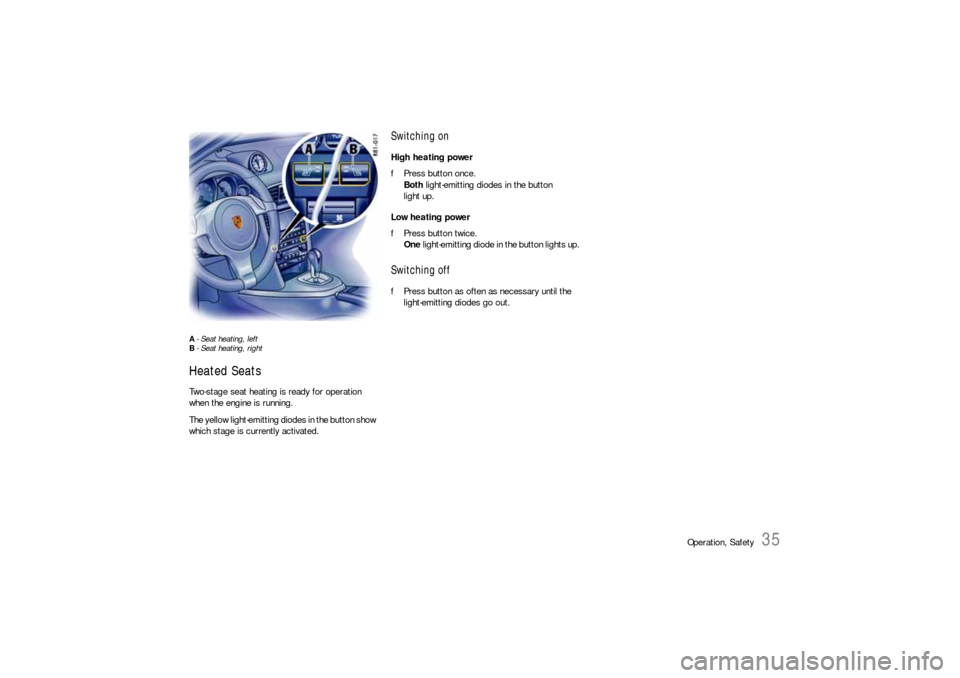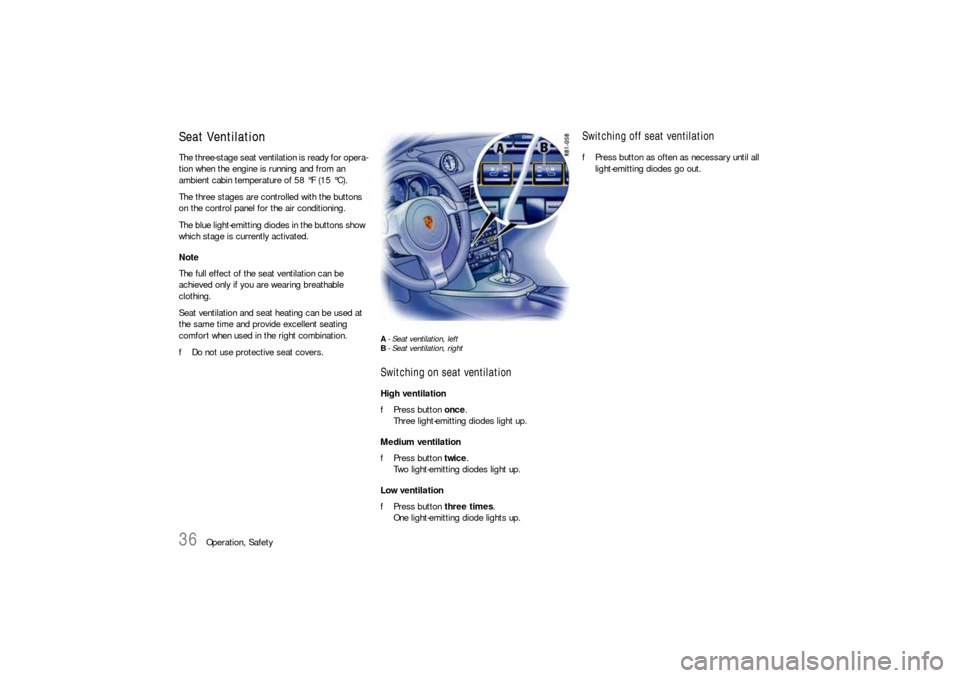engine PORSCHE 911 CARRERA 2010 5.G User Guide
[x] Cancel search | Manufacturer: PORSCHE, Model Year: 2010, Model line: 911 CARRERA, Model: PORSCHE 911 CARRERA 2010 5.GPages: 310, PDF Size: 3.39 MB
Page 17 of 310

Operation, Safety
15
Keys fPlease see the chapter “ALARM SYSTEM, PAS-
SENGER COMPARTMENT MONITORING” on
Page 23.
fPlease see the chapter “CENTRAL LOCKING”
on Page 19.
Two car keys are supplied with your Porsche.
These keys operate all the locks on your vehicle.
fBe careful with your car keys: do not part with
them except under exceptional circumstances.
fTo avoid battery run-down, always remove the
ignition key from the ignition lock.
Replacement keys Replacement car keys can be obtained only from
your authorized Porsche dealer, and this can
sometimes be very time-consuming.
You should therefore always keep a spare key on
your person.
Keep it in a safe place (e.g. wallet), but under no
circumstances in or on the vehicle.
The key codes of new keys have to be “reported”
to the car control unit by your authorized Porsche
dealer.
A total of 6 car keys can be reported to the control
unit.
Disabling key codes
If a key is lost, the key codes can be disabled by
an authorized Porsche dealer.
All the remaining car keys are required for this pur-
pose.
Disabling the code ensures that the car can be
started only using authorized keys.
Note
fPlease note that the other locks can still be
opened with the disabled key.
Immobilizer There is a transponder (an electronic component)
in the key grip, containing a stored code.
When the ignition is switched on, the ignition lock
checks the code.
The immobilizer can be deactivated and the en-
gine started only using an authorized ignition key.
Switching off the immobilizer
fInsert the ignition key into the ignition lock.
If the ignition is left on for more than 2 minutes
without the engine being started, the immobilizer
is switched on again.
fIf this happens, turn the ignition key back to
position 3 (ignition off) before starting the
engine. The immobilizer is switched off again,
and the engine can be started.
fPlease see the chapter “IGNITION/STARTER
SWITCH WITH ANTI-THEFT STEERING LOCK”
on Page 74.
Switching on the immobilizer
fRemove ignition key.Security Wheel Bolts fIf wheels have to be removed during a work-
shop visit, do not forget to hand over the sock-
et for the security wheel bolts along with the
car key.
Page 21 of 310

Operation, Safety
19
Central Locking This device complies with:
Part 15 of the FCC Rules
RSS-210 of Industry Canada.
Operation is subject to the following two condi-
tions:
1. This device may not cause harmful interfer-
ence, and
2. this device must accept any interference re-
ceived, including interference that may cause
undesired operation.
Note
The manufacturer is not responsible for any radio
or TV interference caused by unauthorized modifi-
cations to this equipment.
Such modification could void the user’s authority
to operate the equipment.
Warning!
Any changes or modifications not expressly ap-
proved by Porsche could void the user’s authority
to operate this equipment.
fPlease see the chapter “LOAD SWITCH-OFF AF-
TER 2 HOURS OR 7 DAYS” on Page 258.
fPlease see the chapter “SEAT MEMORY” on
Page 33.Both car doors and the filler flap can be centrally
unlocked or locked with the remote control.
The vehicle cannot be locked if the driver’s door is
not completely closed.
A short signal from the alarm horn will draw
your attention to the fact that the following
components are not completely closed when you
try to lock the vehicle:
– Driver’s door (the vehicle cannot be locked if
the driver’s door is not completely closed).
– Passenger’s door
– Luggage compartment lid
– Engine compartment lid
– Glass rear hatch (Targa)
– Glove compartment
Unlocking the vehicle by using the key in the door
lock and opening the door may activate the alarm
system within 10 seconds.
Note
fOn vehicles with the Sport Chrono Package
Plus, the PCM can be used to activate auto-
matic door locking.
Please observe the chapter “Individual Memo-
ry” in the separate PCM operating instructions.
Automatic relocking If the car is unlocked by remote control and none
of the car doors is opened within approx.
100 seconds, automatic relocking takes place.
This relocking time can be adapted to your individ-
ual requirements (10 - 100 seconds) by an author-
ized Porsche dealer.
Page 24 of 310

22
Operation, Safety
Automatic door locking Your authorized Porsche dealer can program di-
verse types of automatic door locking in the con-
trol unit of the central locking system:
Ty p e 1
Doors lock automatically when the ignition is
switched on.
Ty p e 2
Doors lock automatically when a speed of
3 - 6 mph (5 - 10 km/h) is exceeded. Ty p e 3
Doors lock automatically when the ignition is
switched on. If doors are opened with the engine
running, they lock again automatically when a
speed of 3 - 6 mph (5 - 10 km/h) is exceeded.
Ty p e 4
The doors do not lock automatically.
Note
Automatically locked doors can be unlocked with
the central locking button or opened by pulling on
the inside door handle twice.
fOn vehicles with the Sport Chrono Package
Plus, the PCM can be used to activate automat-
ic door locking.
Please observe the chapter “Individual Memo-
ry” in the separate PCM operating instructions.
Warning!
In an emergency situation where you need to
exit the car through an automatically locked
door, remember the following procedure to
open the door.
fUnlock the doors by pressing the central lock-
ing button or
fpull the inside door handle twice to open the door.
Page 26 of 310

24
Operation, Safety
When the alarm is armed, the following
areas are monitored – Doors
– Luggage compartment lid
– Engine compartment lid
– Convertible-top lock (Cabriolet)
– Glass rear hatch (Targa)
– Glove compartment
– Passenger compartment
If one of these alarm contacts is interrupted, the
alarm horn sounds for approximately 3 minutes.
Additionally, the emergency flasher flashes and
the passenger compartment light lightes for ap-
proximately five minutes.
When the alarm is triggered, the light-emitting
diode changes over to double flashes.
In order not to limit the action range of the passen-
ger compartment monitoring system:
fDo not fold the front seat backrests forward.
Deactivating the passenger compartment
monitoring system for one locking
processIf a person or animal remains in the car while it is
locked, the passenger compartment monitoring
system must be switched off.
fQuickly lock car twice.
The doors are locked but can be opened from
the inside:
1. Pull inner door handle once to unlock door
lock.
2. Pull inner door handle again to open door.
Note
fInform any person remaining in the car that the
alarm system will be triggered if the door is
opened.
Fault indication A double horn signal during locking indicates a
defect in the central locking or alarm system.
fHave the defect remedied at an authorized
Porsche dealer.
Page 27 of 310

Operation, Safety
25
A - Power window in driver’s door
B - Power window in passenger’s door
C - Cabriolet: Switching button for front/rear power
windows
Power Windows
Warning!
Risk of injury when the door windows close.
This applies especially if the windows are
closed with the one-touch operation, be-
cause with this function the window goes up
automatically.
fMake sure that fingers, hands, arms or other
parts are not in the way when the windows are
closed.
fRemove the ignition key to shut off power to
the window switches when the vehicle is not
attended by a responsible person. Uninformed
persons could injure themselves by operating
the power windows.
fIn case of danger, release the button on the
car key immediately.
fDo not leave children in the car unattended.
Risk of an accident.
fDo not put anything on or near the windows that may interfere with the driver’s vision.
Readiness for operation of power windows – When the ignition is switched on
(engine switched on or off) or
– with doors closed and ignition key withdrawn,
but only until door is first opened.
One-touch operation for closing the door
windows is available only when the ignition is
switched on.
Cabriolet
When the convertible top is open, the rear side
windows can only be closed if the door windows
are closed.
Page 37 of 310

Operation, Safety
35
A- Seat heating, left
B-Seat heating, rightHeated SeatsTwo-stage seat heating is ready for operation
when the engine is running.
The yellow light-emitting diodes in the button show
which stage is currently activated.
Switching onHigh heating power
fPress button once.
Both light-emitting diodes in the button
light up.
Low heating power
fPress button twice.
One light-emitting diode in the button lights up.Switching offfPress button as often as necessary until the
light-emitting diodes go out.
Page 38 of 310

36
Operation, Safety
Seat VentilationThe three-stage seat ventilation is ready for opera-
tion when the engine is running and from an
ambient cabin temperature of 58 °F (15 °C).
The three stages are controlled with the buttons
on the control panel for the air conditioning.
The blue light-emitting diodes in the buttons show
which stage is currently activated.
Note
The full effect of the seat ventilation can be
achieved only if you are wearing breathable
clothing.
Seat ventilation and seat heating can be used at
the same time and provide excellent seating
comfort when used in the right combination.
fDo not use protective seat covers.
A- Seat ventilation, left
B- Seat ventilation, rightSwitching on seat ventilationHigh ventilation
fPress button once.
Three light-emitting diodes light up.
Medium ventilation
fPress button twice.
Two light-emitting diodes light up.
Low ventilation
fPress button three times.
One light-emitting diode lights up.
Switching off seat ventilationfPress button as often as necessary until all
light-emitting diodes go out.
Page 50 of 310

48
Operation, Safety Note
The key switch for switching off the passenger’s
airbag in combination with the LATCH attachment
bracket are not installed at the factory. They can
be retrofitted.
fPlease see your authorized Porsche dealer.
Faults are indicated by a warning light in the instru-
ment panel and a message on the on-board com-
puter.
fPlease see the chapter “WARNINGS ON THE
INSTRUMENT PANEL AND THE ON-BOARD
COMPUTER” on Page 158.
fIn the following cases you should immedi-
ately consult an authorized Porsche
dealer in order to assure the airbag sys-
tem is functioning properly:
– If the warning light does not light up when the
ignition key is inserted or
– If the warning light does not go out once the
engine is running or
– If the warning light appears while driving.
Airbag maintenanceIn order to ensure long-term functioning, the air-
bag system must be inspected by an authorized
Porsche dealer at the intervals recommended in
your Maintenance Booklet.
Important information
If you sell your Porsche, notify the purchaser that
the vehicle is equipped with airbags, and refer
them to the chapter, “Airbag Systems“, in the
Owner's Manual (safety and disposal rules).
Further information on the airbag system can be
found on stickers attached to the sun visors.
For special recommendations on the use of child
restraints:
fPlease see the chapter “CHILD RESTRAINT
SYSTEMS” on Page 50.
Warning light and warning
message
Page 62 of 310

60
Operation, Safety
Brake booster The brake booster assists braking only when
the engine is running.
When the car is moving while the engine is not run-
ning, or if the brake booster is defective, more
pressure on the brake pedal is required to bring
the car to a stop.
If this happens, ABS and PSM will also not oper-
ate.
Moisture or road salt on brakes affects braking.
When the vehicle is driven on salted or sanded
roads for extended periods, the brakes should be
washed down thoroughly about every 2 weeks. An
automatic carwash facility cannot do this job prop-
erly.
Brakes will dry after a few cautious brake applica-
tions.
Warning!
Risk of an accident, resulting in serious per-
sonal injury or death.
Driving through water may reduce the trac-
tion.
Moisture on brakes from road water, car
wash, or coating of road salt may affect
braking efficiency.
fCautiously apply brakes to test brakes after ex-posure to road water, etc.
Brake wear Your car has excellent brakes, but they are still
subject to wear. The rate at which they wear de-
pends on how the brakes are used.
fHave the brake system inspected at the
intervals recommended in your Maintenance
Booklet.
Brake system warning light
You can check the functionality of the brake
system warning light by switching the ignition to
the "On" position and verifying that the warning
light illuminates.
If the warning lights in the instrument panel and on-
board computer stay on when the engine is run-
ning or come on while driving, the brake pads are
worn excessively.
fDo not continue to operate the vehicle.
Have your authorized Porsche dealer inspect
or replace the brake pads.
Brake pads Wear on the brake pads and brake discs depends
to a great extent on the driving style and the con-
ditions of use and therefore cannot be expressed
in actual miles on the road.
The high-performance brake system is designed
for optimal braking effect at all speeds and tem-
peratures.
Certain speeds, braking forces and ambient
conditions (such as temperature and humidity)
therefore might cause “brake noises”.
New brake pads or linings
New brake pads and brake discs have to be “bro-
ken in”, and therefore only attain optimal friction
when the car has covered several hundred miles
or km.
The slightly reduced braking ability must be com-
pensated for by pressing the brake pedal harder.
This also applies whenever the brake pads and
brake discs are replaced.
Warning light USA
Warning light Canada
Page 64 of 310

62
Operation, Safety When the ignition is switched on the ABS warning
light will light up while the system is electronically
interrogated and goes out when the engine is
started if the check is not yet complete.
If the ABS warning lamp fails to go out, this indi-
cates that ABS has been deactivated due to a
fault. If the warning lights in the instrument panel
and on-board computer light up while you are driv-
ing, this indicates that a fault has occurred. In both
cases, normal braking, as in vehicles without ABS,
is still retained.
The ABS system should, however, be examined at
an authorized Porsche dealer immediately to pre-
vent the occurrence of further faults.
fIf the ABS system becomes inoperative, take
your vehicle to your authorized Porsche dealer
immediately.
Warning!
Risk of an accident, resulting in serious per-
sonal injury or death.
The control unit of the ABS brake system is
set for standard tire size. If non-standard
tires are installed, the control unit may mis-
interpret the speed of the vehicle, because of
the variant data it receives from the sensors
on the axles.
fUse only tire makes and types tested by Porsche.
Clutch Pedal The clutch pedal must be depressed fully
before the starter will engage.
Warning!
Risk of an accident, resulting in serious per-
sonal injury or death.
fAlways check the movement of the clutch ped-
al before driving and make sure that it is not
obstructed by a floor mat or any other object.
fSecure the floor mat to prevent it from sliding
into positions that could interfere with the safe
operation of your vehicle.
Your Porsche dealer will be glad to offer you
nonskid floor mats of the correct size.
To avoid damage to the clutch and transmis-
sion:
fAlways depress the clutch pedal fully when
changing gears.
fDo not hold the car on a steep grade with the clutch pedal partially depressed.
Should the free travel of the clutch pedal suddenly
become larger, it could mean a malfunction of the
clutch.
fSee your Porsche dealer for correction.
Warning light USA
Warning light Canada